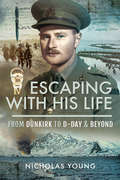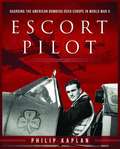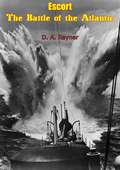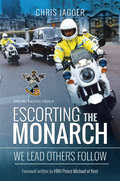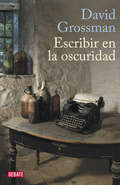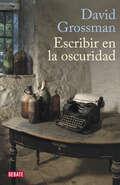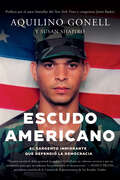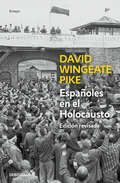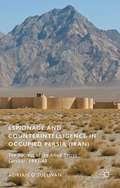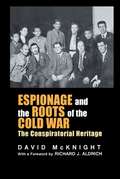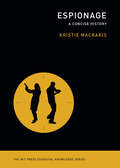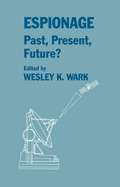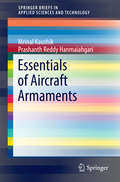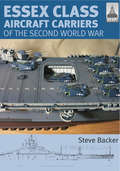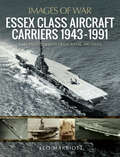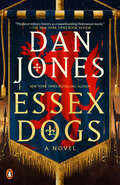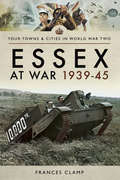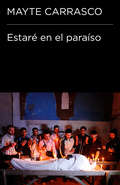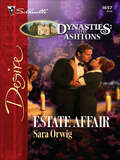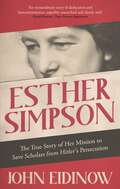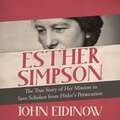- Table View
- List View
Escaping with His Life: From Dunkirk to D-Day & Beyond
by Nicholas Young&“A fitting tribute . . . exceptional in covering the duration of WWII as a soldier, commando, POW, escaper, and on through D-Day to Victory.&” —Firetrench Very few British soldiers could lay claim to such a full war as Leslie Young. Having survived the retreat to and evacuation from Dunkirk, he volunteered for the newly formed Commandos and took part in their first operation, the raid on the Lofoten Islands. He fought and was captured in Tunisia. He went on the run before his POW camp at Fontanellato was taken over by the Nazis after the September 1943 Italian armistice. He spent six months on the run in the Apennine mountains aided by brave and selfless Italians. Many of whom were actively fighting their occupiers. He eventually reached Allied lines but not before several of his companions were tragically killed by both German and American fire. On return to England, he immediately signed up for the invasion of North West Europe and despite being wounded eventually fought through to Germany. It is thanks to his son&’s research that Major Young&’s story can now be told. It is an inspiring and thrilling account which demands to be read. &“Nicely retold by his son, Nicholas, this memoir ticks all the boxes . . . An incredible story of one man&’s war. It&’s excellent.&” —WW2Talk &“This wonderful account of the military life of Leslie Young is pure Boys&’ Own Paper stuff, a tale of heroism and daring, of courage and fortitude. An amazing story, brilliantly told.&” —Books Monthly
Escort Pilot: Guarding the American Bombers Over Europe in World War II
by Philip Kaplan Andy SaundersSpitfire, Mustang, Lightning, Thunderbolt? in the darkest days of World War II, these legendary fighters escorted lumbering heavy bombers over enemy territory, providing protection, drawing cover, and taking on everything Germany’s Luftwaffe could throw at them.Escort Pilot is the lavishly-illustrated celebration of these unique heroes, painstakingly researched and beautifully designed. It conjures up the lost world of these daring US, British, and other Allied pilots. Readers witness gripping, first-hand accounts of deadly dogfights over Germany, accompanied by warm, humorous personal reminiscences of life on the ground, accompanied throughout by hundreds of period photos and reproductions of vintage artifacts and keepsakes - many in full color.Filled with engaging anecdotes, little-known fighter lore, and a wealth of fascinating and colorful details you’d expect ? from favorite, long-forgotten local pubs to personalized flight jacket artwork ? Escort Pilot is a richly evocative reminiscence of a heroic era and the larger-than-life personalities that inhabited it.
Escort: The Battle of the Atlantic (Classics Of Naval Literature Ser.)
by D. A. RaynerThis is the story of one man’s war and of the Royal Navy’s escort vessels—trawlers, corvettes and destroyers—that guarded Britain’s ocean life-lines across the Atlantic against the ravaging forays of U-Boats and surface raiders.This highly acclaimed firsthand account of convoy escort operations in the North Atlantic from 1939 to 1945 is based on Rayner’s astonishing war record.Denys Arthur Rayner was a Royal Navy officer who fought throughout the Battle of the Atlantic. After intensive war service at sea, Rayner became a writer, a farmer, and a successful designer and builder of small sailing craft.
Escorting the Monarch
by Chris JaggerEscorting the Monarch is as close to an official history of the Metropolitan Police's 'Special Escort Group' (SEG) as one could hope for.You may have seen the team at work; as the combination of motorcycles and cars pass you by, they glide elegantly and seemingly effortlessly through busy traffic. Developing a dedicated and diligent team culture, they are masters of their trade. They hold a well-earned reputation for excellence amongst their peers; delivering their passengers (and cargo) on time, safely, in a great deal of style, and without fuss or mishap. Professional and precise in the execution of their operations, they are neither shaken nor stirred.Although the work of the SEG demands exquisitely high levels of presentation there is little room for gloss or glitter. The individuals and property they are charged to protect are assessed by government to need the highest possible levels of protection. From queens, kings, presidents and emperors, to priceless works of art, terrorists and high risk prisoners, the group escort them all.Written by the son of a retired SEG officer who himself served in the British Government's security and intelligence community, Escorting the Monarch is told, in part, through first hand stories and anecdotes gleaned from former officers of the group. The insights offered are unique, privileged and first of their kind. Chris Jagger unfolds a collection of fascinating and never before told stories built on high profile events, such as the funeral of Sir Winston Churchill, and the visit of Nelson Mandela.Now the SEG have honed their skills for over 6 decades. Through a carefully constructed description of a changing security and political environment across the decades, and an insightful analysis of the ingenuity of those who have severed with the SEG, _Escorting the Monarch_ explains the events that made the group who they are today.
Escribir en la oscuridad
by David GrossmanSeis ensayos fundamentales de la obra de Grossman. Escribir en la oscuridad reúne seis ensayos en los que Grossman analiza con maestría y lucidez extraordinaria algunos de los temas centrales en su producción artística: las voces literarias que han ayudado a construir su obra, el Holocausto, la creación del Estado de Israel o los problemas derivados del mismo como marco de sus creaciones; el conflicto en Oriente Próximo y los devastadores efectos que provoca en la sociedad israelí, sometida a un consenso interior asfixiante, así como la incertidumbre acerca del futuro que ilustra el fracaso mayúsculo de un estado surgido precisamente para garantizarlo. Desde una perspectiva humanista, Grossman reivindica que la verdadera literatura se halla irremediablemente vinculada a la política que configura nuestras vidas, y nos ofrece las claves fundamentales para comprender su obra: un retrato extraordinariode las fuentes de la creación y un magnífico alegato en defensa de la paz en Oriente Próximo. Reseña:«El emocionante manifiesto de uno de los escritores más originales y mejor dotados no solo de su país, sino de todo el mundo.»The New York Times Book Review
Escribir en la oscuridad
by David GrossmanSeis ensayos fundamentales de la obra de Grossman. Escribir en la oscuridad reúne seis ensayos en los que Grossman analiza con maestría y lucidez extraordinaria algunos de los temas centrales en su producción artística: las voces literarias que han ayudado a construir su obra, el Holocausto, la creación del Estado de Israel o los problemas derivados del mismo como marco de sus creaciones; el conflicto en Oriente Próximo y los devastadores efectos que provoca en la sociedad israelí, sometida a un consenso interior asfixiante, así como la incertidumbre acerca del futuro que ilustra el fracaso mayúsculo de un estado surgido precisamente para garantizarlo. Desde una perspectiva humanista, Grossman reivindica que la verdadera literatura se halla irremediablemente vinculada a la política que configura nuestras vidas, y nos ofrece las claves fundamentales para comprender su obra: un retrato extraordinario de las fuentes de la creación y un magnífico alegato en defensa de la paz en Oriente Próximo. Reseña:«El emocionante manifiesto de uno de los escritores más originales y mejor dotados no solo de su país, sino de todo el mundo.»The New York Times Book Review
Escudo Americano: El sargento inmigrante que defendió la democracia
by Susan Shapiro Aquilino Gonell&“American Shield&” es una historia típicamente americano sobre el deber y la determinación — maravillosamente contada por un inmigrante, un veterano de guerra, y un patriota.&”Nancy Pelosi, Speaker Emerita de la House of Representatives de los Estados UnidosAquilino Gonell era un jóven cuando llegó a los Estados Unidos de la República Dominicana. Aunque no hablaba inglés, se dedicó a su nueva tierra adoptada, luchando para conseguir el dichoso sueño americano. Su resolución de lograr una vida de éxito le llevó a alistarse en el ejército, como manera de pagar sus estudios universitarios. Tras combatir en Irak, volvió a los EEUU con TEPT, pero siguió con confianza en las promesas del gobierno, y se concentró en su familia y en el proceso de sanarse. Sus labores dieron fruto cuando ganó un puesto muy codiciado con la United States Capitol Police, en la ciudad de Washington DC, y llegó al rango de sargento.Todo cambió para siempre el 6 de enero de 2021. Cuando los insurreccionistas irrumpieron en el Capitolio, con mucha valentía el sargento Gonell no se rindió a los que intentaron frustrar la transferencia pacífica de poder. Las heridas brutales que sufrió aquel día pondría fin a su carrera como agente de policía. Pero justo cuando algunos de los mismos políticos que el sargento defendía intentaron desmentir la verdadera historia de aquel día, él eligió denunciar la injusticia que sufría al igual que el país. Una crónica de lo que significa llevar una vida de principios, una que se adhiere a las mejores nociones de nuestra democracia, American Shield es un testimonio fulgurante del poder la verdad, la justicia y la responsabilidad de la boca de un oficial decorado e inmigrante que ilustra las mejores aspiraciones de una nación agradecida.
Españoles en el holocausto: Vida y muerte de los republicanos en Mauthausen (Arena Abierta Ser.)
by David W. PikeEl presente libro describe la experiencia del gran contingente español confinado en uno de los más terribles campos de concentración nazis, el complejo de Mauthausen. Entre los cientos de miles de prisioneros enviados a este campo, los siete mil españoles que llegaron allí eran republicanos refugiados en Francia que habían luchado en la Guerra Civil y que, tras la invasión nazi, fueron arrestados por las tropas alemanas. Su historia sirve en parte para presentarnos un microcosmos de la experiencia colectiva, pero es al mismo tiempo una experiencia única. Esta cuarta edición ha sido revisada por el autor y ampliada con dos anexos: una lista de los españoles de Mauthausen fallecidos por causas no naturales y una extensa coda que incorpora sus avances en la investigación durante los últimos diez años. Opinión:«Con este solo libro se aprende más que comprendiendo la mayoría de los libros que hay en el mercado.»Gabriel Jackson
Espionage and Counterintelligence in Occupied Persia (Iran): The Success of the Allied Secret Services, 1941-45
by Adrian O’SullivanThe sequel to Nazi Secret Warfare , which portrayed the catastrophic failure of Germany's clandestine services in Persia (Iran) during the Second World War. By contrast but based on equally solid archival evidence, this companion volume tells the other side of the same fascinating story, introducing us to spies, spycatchers, and spymasters.
Espionage and the Roots of the Cold War: The Conspiratorial Heritage (Studies in Intelligence)
by David McKnightFrom the 1930s to the 1950s a large number of left-wing men and women in the USA, Britain, Europe, Australia and Canada were recruited to the Soviet intelligence services. They were amateurs and the reason for their success is intriguing. Using Soviet archives, this work explores these successes.
Espionage: A Concise History (The MIT Press Essential Knowledge series)
by Kristie MacrakisA concise introduction to the history and methods of espionage, illustrated by spy stories from antiquity to today&’s high-tech world.Espionage is one of the most secret of human activities. It is also, as the popularity of spy stories suggests, one of the most intriguing. This book pulls the veil back on the real world of espionage, revealing how spying actually works. In a refreshingly clear, concise manner, Kristie Macrakis guides readers through the shadowy world of espionage, from the language and practice of spycraft to its role in international politics, its bureaucratic underpinnings, and its transformation in light of modern technology. Espionage is a mirror of society and human foibles with the added cloak of secrecy and deception. Accordingly, Espionage traces spying all the way back to antiquity, while also moving beyond traditional accounts of military and diplomatic intelligence to shine a light on industrial espionage and the new techno-spy. As thorough—and thoroughly readable—as it is compact, the book is an ideal introduction to the history and anatomy of espionage.
Espionage: Past, Present and Future? (Studies in Intelligence)
by Wesley K. WarkHighlights of the volume include pioneering essays on the methodology of intelligence studies by Michael Fry and Miles Hochstein, and the future perils of the surveillance state by James Der Derian. Two leading authorities on the history of Soviet/Russian intelligence, Christopher Andrew and Oleg Gordievsky, contribute essays on the final days of the KGB. Also, the mythology surrounding the life of Second World War intelligence chief, Sir William Stephenson, The Man Called Intrepid', is penetrated in a persuasive revisionist account by Timothy Naftali. The collection is rounded off by a series of essays devoted to unearthing the history of the Canadian intelligence service.
Essentials Of Fire Fighting
by Ifsta StaffIFSTA’s Essentials of Fire Fighting, 6th Edition is the most complete and comprehensive Firefighter I and II text on the market. This new edition is completely revised to meet the 2013 edition of NFPA 1001 and brings the most trusted in-depth knowledge content to students and instructors. The manual is 21 chapters and has 1,400 pages. Key features includes: Separation and clear identification of FFI and FFII content; Updated content, skills, and tactics that reflect the latest research from NIST and UL; A student-focused design that incorporates high quality photos and illustrations, photos enhanced with graphics, and improved tables make content more relevant to visual learners; Key terms in the margins, review questions at the end of each chapter, skill sheets and engaging case histories designed to enhance student understanding; Warnings, cautions, and Safety Alerts emphasize firefighter safety for new firefighters who are mastering the 192 FFI and FFII skills
Essentials of Aircraft Armaments
by Mrinal Kaushik Prashanth Reddy HanmaiahgariThis book aims to provide a complete exposure about armaments from their design to launch from the combat aircraft. The book details modern ammunition and their tactical roles in warfare. The proposed book discusses aerodynamics, propulsion, structural as well as navigation, control, and guidance of aircraft armament. It also introduces the various types of ammunition developed by different countries and their changing trends. The book imparts knowledge in the field of design, and development of aircraft armaments to aerospace engineers and covers the role of the United Nations in peacekeeping and disarmament. The book will be very useful to researchers, students, and professionals working in design and manufacturing of aircraft armaments. The book will also serve air force and naval aspirants, and those interested in working on defence research and developments organizations.
Essentials of Public Health Preparedness and Emergency Management
by Rebecca Katz Jim BanaskiThe public health community plays a vital role in identifying, responding to, containing, and recovering from emergencies. Essentials of Public Health Preparedness and Emergency Management takes an all hazards approach to public health preparedness and emergency management by providing broad perspectives on local, national, and global threats. <p><p> The Second Edition adds authoritative coverage of the field of Emergency Management with the addition of a new co-author, James Banaski, Jr., a hands-on emergency management professional. The Second Edition also includes case studies on Ebola and Zika which demonstrate approaches to addressing the threat of emerging infectious diseases. Additional case studies focus on bioterrorism, environmental disasters, and the need for a coordinated approach involving the full range of first responders, public health and clinical health professionals, and a range of other emergency response professionals. <p><p> Key Features: - Assumes no previous exposure to the concepts making it readable for those who are new to Public Health, yet provides enough depth for readers who may have advanced knowledge. - Offers new chapters on The Preparedness Cycle, Practical Applications of Public Health Emergency Management, and Developing a Public Health Emergency Operations Center - Supports mastery of the Public Health Preparedness and Response competencies developed by the Association of School and Programs of Public Health - Includes Navigate 2 Advantage Access that unlocks a complete eBook, Study Center, homework and Assessment Center, and a dashboard that reports actionable data. Experience Navigate 2 today at www.jblnavigate.com/2.
Essex Class Aircraft Carriers of the Second World War (ShipCraft)
by Steve BackerA stern-to-bow look at the most powerful aircraft carrier design of World War Two from the author of Bismarck and Tirpitz in the ShipCraft series. The latest volume covers the hugely important American carrier of the Second World War. Built in larger numbers than any fleet carrier before or since, the Essex class can claim to be the US Navy&’s most significant weapon in the defeat of Japan. Carrying up to 100 aircraft and capable of absorbing enormous punishment (not one was sunk), they spearheaded the Fast Carrier Task Forces for most of the Pacific War. The heavily illustrated work contains everything a modeller needs to know about this prolific class. &“This book is well written and the text is supported by good sharp photos and illustrations. If your interest is World War II warships or ship modelling, this book should be in your library.&”—PowerShips
Essex Class Aircraft Carriers, 1943–1991: Rare Photographs From Naval Archives (Images of War)
by Leo MarriottA photographic history of the US Essex-class aircraft carriers of World War II—including the USS Intrepid that now serves as a New York City museum.Essex-class aircraft carriers played an essential role in the victory of the United States over Japan in the Second World War, and Leo Marriott’s photographic history is a fascinating introduction to them. Without these remarkable ships, the island-hopping campaign of American forces across the Pacific towards Japan would not have been possible. They also took part in the Korean and Vietnam wars that followed.During the Second World War they were at the center of the powerful task groups that could put up hundreds of aircraft to support forces on the ground. They were also prime targets for Japanese air attacks, in particular the kamikaze suicide missions. A total of twenty-four were eventually commissioned including several after the end of the war.The selection of rare photographs and the expert text cover the evolution of US aircraft carrier design prior to the Second World War and look at the factors which shaped the design and construction of the Essex class. Included are dramatic action shots of the new breed of naval aircraft that was launched from their flight decks, including Hellcat and Corsair fighters that took on the Japanese and the carrier-borne jets that flew over Korea and Vietnam.“An outstanding book.” —Anchorwatch“A book that will surely delight all naval history enthusiasts because it well illustrates the importance that the aircraft carrier had in changing the way warfare is waged at sea.” —On the Old Barbed Wire
Essex Class Aircraft Carriers, 1943–1991: Rare Photographs From Naval Archives (Images of War)
by Leo MarriottA photographic history of the US Essex-class aircraft carriers of World War II—including the USS Intrepid that now serves as a New York City museum.Essex-class aircraft carriers played an essential role in the victory of the United States over Japan in the Second World War, and Leo Marriott’s photographic history is a fascinating introduction to them. Without these remarkable ships, the island-hopping campaign of American forces across the Pacific towards Japan would not have been possible. They also took part in the Korean and Vietnam wars that followed.During the Second World War they were at the center of the powerful task groups that could put up hundreds of aircraft to support forces on the ground. They were also prime targets for Japanese air attacks, in particular the kamikaze suicide missions. A total of twenty-four were eventually commissioned including several after the end of the war.The selection of rare photographs and the expert text cover the evolution of US aircraft carrier design prior to the Second World War and look at the factors which shaped the design and construction of the Essex class. Included are dramatic action shots of the new breed of naval aircraft that was launched from their flight decks, including Hellcat and Corsair fighters that took on the Japanese and the carrier-borne jets that flew over Korea and Vietnam.“An outstanding book.” —Anchorwatch“A book that will surely delight all naval history enthusiasts because it well illustrates the importance that the aircraft carrier had in changing the way warfare is waged at sea.” —On the Old Barbed Wire
Essex Dogs: A Novel (Essex Dogs Trilogy #1)
by Dan JonesA Kirkus Reviews Best Book of 2023The New York Times bestselling historian makes his historical fiction debut with an explosive novel set during the Hundred Years' War.July 1346. Ten men land on the beaches of Normandy. They call themselves the Essex Dogs: an unruly platoon of archers and men-at-arms led by a battle-scarred captain whose best days are behind him. The fight for the throne of the largest kingdom in Western Europe has begun. Heading ever deeper into enemy territory toward Crécy, this band of brothers knows they are off to fight a battle that will forge nations, and shape the very fabric of human lives. But first they must survive a bloody war in which rules are abandoned and chivalry itself is slaughtered. Rooted in historical accuracy and told through an unforgettable cast, Essex Dogs delivers the stark reality of medieval war on the ground – and shines a light on the fighters and ordinary people caught in the storm.
Essex at War, 1939–45 (Your Towns & Cities in World War Two)
by Frances ClampAlthough much maligned, Essex is a vibrant county with a long and exciting history. Being close to the Continent and with one of Britains longest coastlines, it was an obvious target for invasion as the threat of war grew. Many defensive structures were built by the sea and to protect major routes across the county. The remains of pill boxes can still be seen.Essex at War 1939–1945 tells how war greatly affected the county: children were evacuated both to and from Essex; being close to London the county suffered from regular air attacks; farming was important and the Womens Land Army arrived in force. Accounts of Essex airmen and sailors who supported those escaping from Dunkirk are told, and once the USA entered the war there was a new type of invasion in the county when their servicemen arrived and were welcomed at many of the countys airfields.Memories of children growing up during those difficult years are recalled. These include nights spent in cold, damp Anderson shelters, sleeping under solid tables or in claustrophobic Morrison shelters. We learn about disrupted school lessons and the fear felt when the air raid siren wailed. When the V-1 and V-2 unmanned flying bombs were launched in 1944, many still remember listening for the engines to switch off and counting the seconds until they fell to earth.
Estaré en el paraíso (Colección Endebate #Volumen)
by Mayte CarrascoUna cuidada antología de la obra de Augusto Monterroso, máximo exponente del género del microrrelato. Se presenta aquí una cuidada antología que traza un camino de ida y vuelta sobre la obra de Augusto Monterroso, amigo de las cosas irónicamente simples y máxima figura del género más breve de la literatura: el microrrelato. Articulado en dos bloques complementarios, este volumen recoge los cuentos y ensayos más narrativos del autor, proporcionando un viaje a la felicidad y a la sencillez, a la gracia y a la discreción, al humorismo y a la tristeza. Un tímido homenaje al más refinado de los escritores hispanoamericanos. Gabriel García Márquez dijo...«Hay que leerlo manos arriba. Su peligrosidad se funda en la sabiduría y la belleza mortífera de la falta de seriedad.»
Estate Affair (Dynasties: The Ashtons #6)
by Sara OrwigSUDDENLY CINDERELLAMaid Lara Hunter knew a one-night stand with a stranger wasuncharacteristic of her. Her mysterious lover seemed like an ancientprince, sensual and primitive, come to take her away from her humdrumlife. Away from the memories of her employer's humiliation and towardthe kind of desire she'd only read about….But Eli Ashton was no prince—he was her hated employer's estrangedson! Lara had had enough of the Ashtons and their arrogant ways. Butwhen Eli claimed her, her body obeyed his command. Yet her independentstreak forbade her to give him her heart: she would come to Eli Ashtonon her own terms—or not at all!
Esther Simpson: The True Story of her Mission to Save Scholars from Hitler's Persecution
by John EidinowMany of the academic refugees Esther Simpson helped rescue are well remembered. But who was she and why has history forgotten her?This is the story of Esther Simpson, a woman whose dedication to the cause of freedom in science and learning left an indelible mark on the cultural and intellectual landscape of the modern world.Esther Simpson - Tess to her friends - devoted her life to resettling academic refugees, whom she thought of as her family. By the end of her life, Simpson could count among her 'children' sixteen Nobel Prize winners, eighteen Knights, seventy-four fellows of the Royal Society, thirty-four fellows of the British Academy. Her 'children' made a major contribution to Allied victory in World War Two.From a humble upbringing in Leeds to Russian immigrant parents, Simpson took on secretarial roles that saw her move to Paris, Vienna and Geneva. But when Hitler assumed power in 1933, she took a job in London at the Academic Assistance Council, newly set up to rescue displaced German scholars, and found her lifelong calling.For a woman who befriended so many and such eminent 'children', surprisingly little is known of her. This book is a study of Esther Simpson: who she was and how she lived, what moved her to take up and never to relinquish her calling, her impact on the world, and the historical context that helped shape her achievements.
Esther Simpson: The True Story of her Mission to Save Scholars from Hitler's Persecution
by John EidinowMany of the academic refugees Esther Simpson helped rescue are well remembered. But who was she and why has history forgotten her?This is the story of Esther Simpson, a woman whose dedication to the cause of freedom in science and learning left an indelible mark on the cultural and intellectual landscape of the modern world.Esther Simpson - Tess to her friends - devoted her life to resettling academic refugees, whom she thought of as her family. By the end of her life, Simpson could count among her 'children' sixteen Nobel Prize winners, eighteen Knights, seventy-four fellows of the Royal Society, thirty-four fellows of the British Academy. Her 'children' made a major contribution to Allied victory in World War Two.From a humble upbringing in Leeds to Russian immigrant parents, Simpson took on secretarial roles that saw her move to Paris, Vienna and Geneva. But when Hitler assumed power in 1933, she took a job in London at the Academic Assistance Council, newly set up to rescue displaced German scholars, and found her lifelong calling.For a woman who befriended so many and such eminent 'children', surprisingly little is known of her. This book is a study of Esther Simpson: who she was and how she lived, what moved her to take up and never to relinquish her calling, her impact on the world, and the historical context that helped shape her achievements.
Esther Simpson: The True Story of her Mission to Save Scholars from Hitler's Persecution
by John EidinowMany of the academic refugees Esther Simpson helped rescue are well remembered. But who was she and why has history forgotten her?This is the story of Esther Simpson, a woman whose dedication to the cause of freedom in science and learning left an indelible mark on the cultural and intellectual landscape of the modern world.Esther Simpson - Tess to her friends - devoted her life to resettling academic refugees, whom she thought of as her family. By the end of her life, Simpson could count among her 'children' sixteen Nobel Prize winners, eighteen Knights, seventy-four fellows of the Royal Society, thirty-four fellows of the British Academy. Her 'children' made a major contribution to Allied victory in World War Two.From a humble upbringing in Leeds to Russian immigrant parents, Simpson took on secretarial roles that saw her move to Paris, Vienna and Geneva. But when Hitler assumed power in 1933, she took a job in London at the Academic Assistance Council, newly set up to rescue displaced German scholars, and found her lifelong calling.For a woman who befriended so many and such eminent 'children', surprisingly little is known of her. This book is a study of Esther Simpson: who she was and how she lived, what moved her to take up and never to relinquish her calling, her impact on the world, and the historical context that helped shape her achievements.
